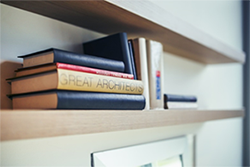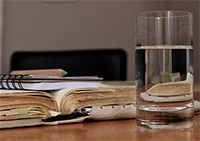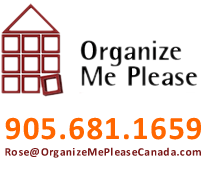I have a love of books that date back to being a toddler, when my mom would read “I Wish That I Had Duck Feet” by Dr. Seuss. I remember gently rocking back & forth in a rocking chair while the rhyming words swirled around in my toddler head—this was just the start of my love affair with books.
Until just a few years ago, I had 2 huge book cases that were double-stacked with volumes ranging from children’s fiction to college text books, and piles had formed next to couches and the bed. I could not imagine my life without these friends surrounding me.
Today, I am the proud owner of approximately 20 books – six of which are craft books. To move from one extreme to the other took some serious work, and time (and a newfound appreciation for library books). Here are a few suggestions to help even the biggest bibliophile relieve your sagging shelves of stress—without buying more shelves.
owner of approximately 20 books – six of which are craft books. To move from one extreme to the other took some serious work, and time (and a newfound appreciation for library books). Here are a few suggestions to help even the biggest bibliophile relieve your sagging shelves of stress—without buying more shelves.
How to Declutter your Bookshelves:
1. Divide and Conquer – Get ruthless with your “yet to read” pile
 My rule of thumb is simple: If it hasn’t been read in six months, it probably won’t ever be read. If you’re not sure, dedicate a space to “need to read” books, and note the date. Any books that started out on that shelf on that date but were still there six months… do you really intend to read them?
My rule of thumb is simple: If it hasn’t been read in six months, it probably won’t ever be read. If you’re not sure, dedicate a space to “need to read” books, and note the date. Any books that started out on that shelf on that date but were still there six months… do you really intend to read them?
If you’re concerned that you’ll still want to read something, make a note of it in your notebook – title, author, ISBN – so you can find a library copy in the future.
2. Share with others!
Anytime you find yourself thinking “So and so would LOVE this book!” write that name down on a sticky note, stick it on the front cover, and set the book aside.
3. Check for overlap of non-fiction information
Organize your non-fiction books by topic, then see if you have multiple books on the same topic. Is the content overlapping?
When I sorted through my shelves, once I saw where I had doubled up on topic, it was easier to let go of a few books.
4. Consider why you are attached to the book
If a book is not one you read or refer to often, consider whether you are keeping it because of how the story made you feel, or because it was a meaningful gift.
To reduce your attachment to the book itself, take a few minutes to write about your connection to the book, or even take a photograph of it, and once your emotions and thoughts are out of your head, it is easier to let the book be enjoyed by a new person. (Of course, if the book was a gift from a friend or relative who would note its absence, you might want to keep it around for when s/he visits!)
5. Look for multiple copies
Do you really need two copies of that book? Was one a gift? Decide which version you want to keep, and send the other(s) to a new home for someone else to appreciate and enjoy.
6. Set aside one shelf as your “deserted island” shelf
 This shelf is for the books I’d want with me if I were stranded on a deserted island, that I could read over and over again for the rest of my life. As you are sorting through the texts, move these books to a dedicated shelf.
This shelf is for the books I’d want with me if I were stranded on a deserted island, that I could read over and over again for the rest of my life. As you are sorting through the texts, move these books to a dedicated shelf.
Not only is it comforting to have a “saved” section as you pare down others, but you now have a physical boundary – you can have no more “desert island” books than will fit on this one shelf, so you are forced to really think about your collection.
Here are a few tips to help you along the way:
- Ensure you have a
 notebook, sticky notes, a pen, & boxes or sturdy reusable bags – If your book-rehoming supplies are not on hand, you’ll have an excuse for why you can’t sort or get rid of them.
notebook, sticky notes, a pen, & boxes or sturdy reusable bags – If your book-rehoming supplies are not on hand, you’ll have an excuse for why you can’t sort or get rid of them. - Stay hydrated – Keeping a glass of water nearby will help you stay alert and focused, and away from getting distracted in the kitchen.
- Set a timer – Sort through your books
 for no more than 30 minutes the first go-round to avoid overwhelm.
for no more than 30 minutes the first go-round to avoid overwhelm. - If you begin to feel overwhelmed – Take a few minutes away from the shelves. This is a new experience for you and it takes some getting used to!
- Group books into categories – then work through one category at a time.
- Honour your emotions – Your sentimental attachment to your books is not something to feel ashamed of. Acknowledging your emotions as you sort through your books can be the first step in helping you move past that attachment and towards a more minimalist book collection.
And remember: you acquired these books over time, so it will likely take some time to sort and re-home your textual friends. By spending a few minutes per week dedicated to letting go of a few books at a time, you may find your feelings shifting towards the stories and the moment rather than the books themselves.
Last but not least, after your shelves are sorted, consider using one of my favourite rules for avoiding book clutter—One book in, one book out!








